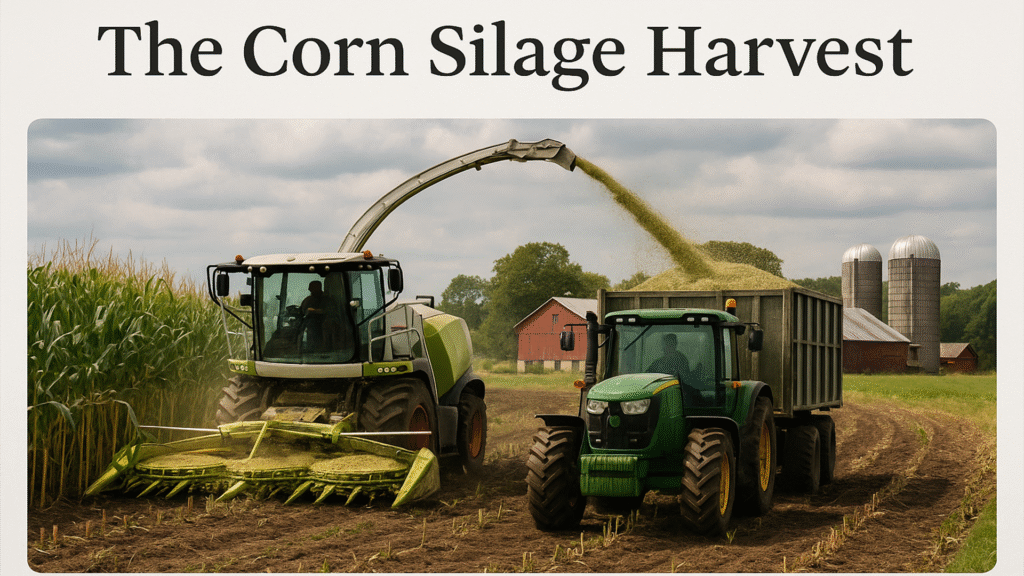
Overview
Corn silage harvest is a major step and a crucial phase in livestock feed production for dairy and beef cattle operations, involving the cobs, kernels, leaves, and stalks. The accurate stage is selected to start the harvest process.
Corn silage ensures a balance in energy-rich starch and Fiber. With the help of experts and harvesters, this plant is chopped into small, equal pieces. It can maximize yield per Acre and improve fermentation and arranging efficiency.
Major Points of the Corn Silage Harvest Process
1- Optimal Harvest Timing
Optimal harvest timing is a major point to produce high-quality corn silage for farmers and harvesters. Their target is to produce cost-effective Feed as well. The right time to harvest is when this plant remains ½ or 2-third milk stage with accurate moisture content.
For proper fermentation the plant is ready with the required moisture to avoid nutrient runoff and poor fermentation. The team closely monitors or checking of plant in the lab with testers to find out the window. This is best time for farmers to improve the quality of silage and animal health.
2- Improved Digestibility
- Enhanced Rumen Fermentation
- Supports Better Nutrient Absorption
- Decreases Undigested Feed Waste
3- Balanced Nutrient Profile
- Stable Moisture Content
- Provides Essential Nutrients
- Reduces Need for Supplements
4- Reduces Supplemental Feed Needs
- Minimizes Dependency on Grains
- Reduces Protein Supplements
- Cost Savings on Feed Inputs
5- Reduces Field and Storage Losses
- Corn silage reduces storage and field as compared to other processes of harvesting. The corn plant is chopped finely and produce required or essential moisture level. A proper nutrient protects from sun or proper ensiling in bunkers, bags, and silos as it will limit oxygen and provide good quality feed without any waste.
- Quick harvest procedure decreases the time and risk of nutrient loss in over-drying, storms, or rains. The purpose is to produce healthy feed recovery, so this process is controlled with the help of fermentation. It will prevent bacteria. As a result, a good quality feed is provided to dairy animals.
6- Optimal Moisture Content
- Reduces Seepage Losses
- Minimizes Mold and Spoilage
- Improves Packing Density
7- Efficient Fermentation
- Rapid pH Reduction
- Promotes Lactic Acid Bacteria Activity
- Minimizes Nutrient Loss
8- Complete sealing prevents Air Exposure
- Preserves Nutrient Quality
- Improves Silage levels
- Reduces Dry Matter Loss
9- Supports Consistent Feeding
- The regular intake is provided to dairy animals that maximizes the digestive process and improves health. Corn silage is a balanced source of nutrients for the whole year. It increases animal performance.
- Reliable content makes life easy for farmers as they can produce a balanced diet. This will sort out problems of uneven intake of Protein, starch, and Fiber. Corn silage is an ideal content for animals that decreases the risk of acids or an upset digestive system. The efficient use of resources is also important for farmers.
10- Improves Rumen Stability
- Promotes Healthy Fermentation
- Supports Microbial Efficiency
- Enhances Digestive Efficiency
11- Supports Predictable Animal Performance
- Consistent Nutrient Supply
- Stabilizes Rumen Function
- Reduces Feed Variation
12- Simplifies Ration Formulation
- Saves Time and Labor
- Consistent Nutrient Content
- Reduces Need for Complex Adjustments
13- Whole-Plant Harvesting
- The process of harvesting corn consists of maximizing yield per acre. The farmers can easily capture both Fiber and high-energy grains. It makes for easy formulation and cost-effective for farmers. Also, efficiency is increased, and corn is grown. The whole-plant harvesting plays a major role in maintaining sustainability.
- It will deliver a perfect mixture of moisture, Fiber, and carbohydrates for animals, diet. Whole plant harvesting of corn silage increases the efficiency of resources and maximizes growth of crops that supports farming practices.
14- Simplifies Harvesting Process
- Lower Labor Costs
- Consistent Chop and Processing
- Improves Operational Efficiency
15- Improves Feed Consistency
- Uniform Nutrient Composition
- Reduces Daily Variations
- Supports Ration Stability
16- Supports Efficient Fermentation
- Preserves Nutrient Value
- Limits Dry Matter Loss
- Improves Silage Stability
17- Rapid Transport and Packing
- Rapid transport and packing is an important part of the corn silage process that ensures the quality of feed and no loss of nutrients for a long time. A quick transport prevents forage and early fermentation. This content helps to manage content, and prompt packing is very critical and necessary for complete fermentation.
- Packing corn silage is a major step that provides long-term protection from bacteria and minimizes shrink. A good packing will improve shelf life and provide high-quality corn silage.
18- Ensures Anaerobic Conditions
- Promotes Lactic Acid Fermentation
- Rapid pH Drop
- Preserves Nutrient Content
19- Reduces Dry Matter Loss
- Efficient Fermentation
- Limits Mold and Yeast Activity
- Minimizes Heating During Storage
20- Improves Fermentation Efficiency
- Faster pH Reduction
- Reduces Undesirable Microbial Activity
- Preserves Nutrient Integrity


